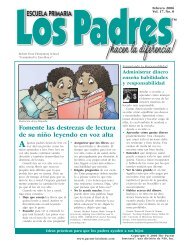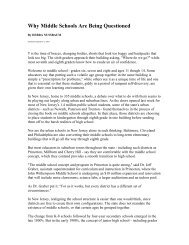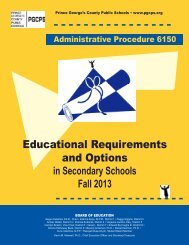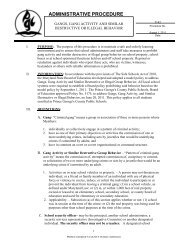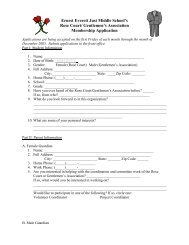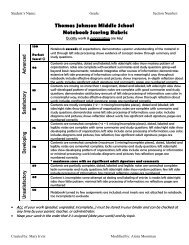Section I: Executive Summary 1 - Prince George's County Public ...
Section I: Executive Summary 1 - Prince George's County Public ...
Section I: Executive Summary 1 - Prince George's County Public ...
You also want an ePaper? Increase the reach of your titles
YUMPU automatically turns print PDFs into web optimized ePapers that Google loves.
<strong>Section</strong> I: <strong>Executive</strong> <strong>Summary</strong><br />
Introduction<br />
James H. Harrison Elementary School is a Title 1 school located in Laurel, Maryland in close proximity to<br />
the Baltimore/Washington Parkway. The instructional school day begins at 7:45 and ends at 1:55. The school<br />
opened in 1967 as a comprehensive community school serving kindergarten through sixth grade. In 1986, the<br />
Comprehensive Special Education Program (CSEP), formerly known as the Diagnostic Wing, became part of the<br />
school. The classes in the program embrace students with various disabilities which includes students with emotional<br />
impairment, speech and language delays, learning disabilities, and as well as those students with fine and gross<br />
motor delays. James H. Harrison is one of six elementary schools serving the Laurel Cluster and is the only school of<br />
the six with a CSEP program. The school has two Community-Referenced Instruction (CRI) classes in the program<br />
that service students with autism, mental retardation, and physical disabilities. We have approximately 12 students<br />
who are a part of our CSEP but are in a more restricted environment in the Community Referenced Instruction<br />
Program (CRI). These students are grouped in a primary or an intermediate class. They are not accessing the<br />
<strong>Prince</strong> George’s <strong>County</strong> <strong>Public</strong> School (PGCPS) Curriculum and are therefore, assessed with the Alternative MSA<br />
(ALT MSA) test. There are 10 special education teachers, 10 paraprofessionals, and 4 classroom assistants (CA).<br />
The Comprehensive Special Education Program receives assistance from 1.0 CSEP Coordinator, 1.0 motor teacher,<br />
2.0 speech and language pathologist, 0.4 vocal music teacher, 1.0 crisis intervention resource teacher and 0.4<br />
school psychologist.<br />
The majority of the general education students live within walking distance of the school which provides a<br />
neighborhood-community school environment for the students and parents of James H. Harrison. The majority of the<br />
CSEP students live within five miles of the school, and bus service is provided for these students. The school’s vision<br />
is to ensure that all students acquire the information, skills, and ability to apply knowledge, while becoming lifelong<br />
learners and productive citizens in a diverse, global society.<br />
James H. Harrison failed to make adequate yearly progress (AYP) in both math and reading in the special<br />
education subgroup school year 2005-2006 (SY05). In addition, AYP was not met in reading for the Free and<br />
Reduced Meals Students (FARMS) and for students of the African American subgroups. The school is currently<br />
classified as an Intensive Support Intervention School (ISIS) in year two of School Improvement. One hundred<br />
fifteen (115) students, 28% of the student population, received special education services during SY05. Of the<br />
students in this subgroup, 12.3% performed at the proficient level in reading. This reflects an increase of 7% from the<br />
school year 2004- 2005 (SY04). In mathematics, 20% of the special education population scored at the proficient<br />
level which was an increase of 9.5% from SY04. The Regional Assistant Superintendent has assigned regional<br />
personnel to provide additional oversight and technical assistance to this school. Timelines and specific tasks are<br />
identified in the professional development calendar in conjunction with the monitoring tool of the school improvement<br />
plan to make improvements in the students’ educational experiences. James H. Harrison Elementary School will be<br />
able to improve student achievement in all academic programs by implementing initiatives such as a daily Drop<br />
Everything and Read (D.E.A. R.) time for all students, weekly instructional day, targeted staff development, and the<br />
extended day learning opportunities for all students. The extended day learning opportunities are offered to students<br />
in the CSEP Program in grades K- 6 th , and to the general education population from 3rd -6 th grade. The targeted staff<br />
development components include a four - module training on using the Voluntary State Curriculum (VSC) in reading<br />
from the Maryland State Department of Education (MSDE) for all teachers and follow-up training for general<br />
educators in grade 3-6. The instructional day offers collaborative planning time to one grade level per week for 1<br />
hour and 30 minutes. This time is provided on a rotating basis to each grade level.<br />
School Demographics<br />
For the SY05, James H. Harrison was staffed with 23 classroom teachers and 15 support staff. The<br />
instructional support staff included the following: a reading specialist, a reading recovery teacher, a math coordinator,<br />
a science coordinator, a social studies coordinator, a technology coordinator, two special education resource<br />
teachers, and a guidance counselor. The school was also supported with two vocal music teachers and one half-time<br />
instrumental music teacher. Additional staff members included one full time and one half time speech teacher and<br />
one full time occupational therapist. The school was also supported by one full-time physical education teacher and<br />
School Improvement Plan, 2006-2007 1 James H. Harrison Elementary School
<strong>Section</strong> I: <strong>Executive</strong> <strong>Summary</strong><br />
one half-time motor skills development teacher. The teachers included 38 certified teachers and 2 provisional<br />
teachers.<br />
Four hundred six students were enrolled at James H. Harrison in SY05 including the following: forty-seven<br />
(47) kindergarteners, sixty-three (63) first graders, forty-five (45) second graders, fifty-six (56) third graders, seventytwo<br />
(72) fourth graders, fifty-eight (58) fifth graders, and sixty five (65) sixth graders. The racial composition of the<br />
student body at James H. Harrison includes: seventy-seven and nine-tenths (77.9%) African American students, ten<br />
and thirty-four hundredths percent (10.34%) White students, nine and thirty-six hundredths percent (9.36%) Hispanic<br />
students, two and seventy-one hundredths percent (2.71%) Asian students, one percent (1%) Native - American<br />
students. Community-based business partnerships with James H. Harrison included the following Laurel businesses,<br />
Old Country Buffet, Don Pablo’s, and McDonalds. The community business partnerships were formed in order to<br />
strengthen the community-school ties.<br />
Major initiatives and how these efforts will improve student performance.<br />
The priorities of the school are to improve achievement of the students who fall into the subgroups of special<br />
education students, African American students, and Free and Reduced Meals Students (FARMS). The school will<br />
use the Quality School Program Strategic Plan as a guide as we work cooperatively to ensure the success of all our<br />
students. The implementation of this plan will ensure that the school’s personnel, parents and community resources<br />
are focused on achieving a shared vision of improved achievement by all students. Parents are encouraged to<br />
participate in their child’s education by volunteering in the schools to help in the classrooms or read with the children.<br />
Parent nights will be scheduled to provide parents with information about academic programs so that the parents can<br />
be more effective in helping their children with their nightly homework in all subject areas including math and reading.<br />
Continued encouragement is given for parents and teacher to join the PTA and attend monthly meetings to increase<br />
parental/school collaboration. James H. Harrison Elementary School will be able to improve student achievement in<br />
all academic programs by implementing initiatives such as Drop Everything and Read (D.E.A. R.), tracking daily<br />
attendance, weekly instructional day, targeted staff development, and the extended day learning opportunities for all<br />
students. The weekly instructional day allows 1 and ½ hours of collaborative planning time with the Instructional<br />
Team for teachers from one grade level every week. This time is rotated through the grade levels so each grade<br />
level gets this time approximately every seven weeks. Although staff development is mainly focused on reading<br />
instruction, math and science staff development will also be provided. Additionally, Maryland State Department of<br />
Education (MSDE) will assist in providing training utilizing the VSC for reading instruction and daily planning.<br />
Subgroups<br />
After a thorough analysis of data, including the MSA data for the 2005-2006 school year, many initiatives will<br />
be put into place to address the needs of all the Elementary Secondary Education Act (ESEA) subgroups<br />
represented at James H. Harrison (African American, FARMS, and Special Education).<br />
African-American<br />
In order to address the academic needs of the African-American population, James H. Harrison will continue<br />
to focus on the five essential reading components (phonemic awareness, phonics, fluency, vocabulary, and<br />
comprehension) and all measurable areas of mathematics (algebra, patterns and functions, geometry and<br />
measurement, number relationships and computations, statistics, and data analysis, and problem solving) as<br />
academic priorities. On a weekly basis the reading specialist and math coordinator will use the <strong>Prince</strong> George’s<br />
<strong>County</strong> <strong>Public</strong> Schools (PGCPS) Curriculum Framework Progress Guides to monitor for effective, productive,<br />
differentiated instruction in both reading and math, and the implementation of effective techniques and teaching<br />
strategies. Quarterly reading and math benchmark exams, weekly classroom assessments, and student portfolios will<br />
be shared and analyzed at quarterly data utilization meetings. The data from benchmarks will be broken down by<br />
subgroup and analyzed accordingly so that the needs of each subgroup, including the African-American student, can<br />
be identified and addressed. Approximately once every seven weeks each grade level will be provided with an<br />
instructional day, which will provide teachers an opportunity for collaborative planning in order to guide instruction<br />
and to meet the needs of this subgroup and others.<br />
School Improvement Plan, 2006-2007 2 James H. Harrison Elementary School
<strong>Section</strong> I: <strong>Executive</strong> <strong>Summary</strong><br />
An extended day program will be implemented to address the needs of the students, including those in the<br />
African-American subgroup, with areas of weakness in reading and math. The program will provide additional<br />
instruction in math and reading to students in grades three through six, two times per week for a period leading up to<br />
the Maryland School Assessment (MSA). Students will be selected for participation in the program based on<br />
Scholastic Reading Inventory (SRI) scores, classroom teacher observations, and teacher recommendations. Pre and<br />
post tests will evaluate students’ level of achievement upon entry to and exit from the program. Data will be compiled<br />
and shared with the James H. Harrison staff.<br />
James H. Harrison will implement the PGCPS systemic reading program published by Houghton Mifflin (K –<br />
5) and McDougal Little (6 th ). In grades K – 2, the reading/language arts block will be 135 uninterrupted minutes. In<br />
grades 3 – 5, the reading/language arts block will be 105 uninterrupted minutes. The sixth grade reading/language<br />
art block will be 90 minutes. The PGCPS systemic reading program emphasizes the following five essential<br />
components of reading: phonemic awareness, phonics, fluency, vocabulary, and comprehension. The program also<br />
includes strategies that align with the Voluntary State Curriculum (VSC). The teachers will receive professional<br />
development focused on using the VSC to effectively scaffold lessons to meet the needs of all learners including<br />
those in the African-American subgroup. In addition to the PGCPS systemic reading program, James H. Harrison will<br />
implement a daily “Drop Everything and Read” (D.E.A.R) time to improve comprehension skills and fluency.<br />
James H. Harrison will implement technology in every classroom to support learning in math and reading.<br />
Through the use of instructional software provided by Houghton Mifflin, Scott Foresman, McDougal Little, and<br />
Pearson Education, students’ technology skills and knowledge will increase.<br />
In the area of math, James H. Harrison will implement the PGCPS systemic math program published by<br />
Scott Foresman (K – 5) and Pearson Education (6 th ). In grades K – 5 teachers will implement 75 uninterrupted<br />
minutes of mathematics instruction. Sixth grade teachers will implement 90 uninterrupted minutes of mathematics.<br />
Staff development trainings will be provided for all teachers in the area of mathematics and reading so that teachers<br />
can differentiate their instruction to meet the needs of students at any level, including those in the African-American<br />
subgroup. Topics for these trainings will include the following: use of manipulatives, technology integration, and<br />
incorporating reading and writing into the mathematics curriculum.<br />
Free and Reduced Meals (FARMS)<br />
Many of the students who fall into the FARMS subgroup are the same as those in the African-American<br />
subgroup. Because of this, the strategies implemented are the similar to address the needs of these students.<br />
James H. Harrison will continue to focus on the five essential reading components (phonemic awareness, phonics,<br />
fluency, vocabulary, and comprehension) and all measurable areas of mathematics (algebra, patterns and functions,<br />
geometry and measurement, number relationships and computations, statistics, and data analysis, and problem<br />
solving) as academic priorities. On a weekly basis the reading specialist and math coordinator will use the <strong>Prince</strong><br />
George’s <strong>County</strong> <strong>Public</strong> Schools (PGCPS) Curriculum Framework Progress Guides to monitor for effective,<br />
productive, differentiated instruction in both reading and math, and the implementation of effective techniques and<br />
teaching strategies. Quarterly reading and math benchmark exams, weekly classroom assessments, and student<br />
portfolios will be shared and analyzed at quarterly data utilization meetings. The data from benchmarks will be broken<br />
down by subgroup and analyzed accordingly so that the needs of each subgroup, including the FARMS subgroup,<br />
can be identified and addressed. An instructional day will be provided approximately once every seven weeks for<br />
each grade level to provide teachers an opportunity for collaborative planning to guide instruction to meet the needs<br />
of this subgroup and others.<br />
An extended day program will be implemented to address the needs of the students, including those in the<br />
FARMS subgroup, with areas of weakness in reading and math. The program will provide additional instruction in<br />
math and reading to students in grades three through six, two times per week for a period leading up to the Maryland<br />
School Assessment (MSA). Students will be selected for participation in the program based on Scholastic Reading<br />
Inventory (SRI) scores, classroom teacher observations, and teacher recommendations. Pre and post tests will<br />
evaluate students’ level of achievement upon entry to and exit from the program. Data will be compiled and shared<br />
with the James H. Harrison staff. In addition, those students who fall into the FARMS subgroup and are in the CSEP<br />
program are given the option of participating in free tutoring provided by “The Enrichment Centers” in the school<br />
School Improvement Plan, 2006-2007 3 James H. Harrison Elementary School
<strong>Section</strong> I: <strong>Executive</strong> <strong>Summary</strong><br />
twice a week for two hours. This program uses the Voyager reading curriculum to reinforce the reading strategies<br />
taught in class.<br />
James H. Harrison will implement the PGCPS systemic reading program published by Houghton Mifflin (K –<br />
5) and McDougal Little (6 th ). In grades K – 2, the reading/language arts block will be 135 uninterrupted minutes. In<br />
grades 3 – 5, the reading/language arts block will be 105 uninterrupted minutes. The sixth grade reading/language<br />
art block will be 90 minutes. The PGCPS systemic reading program emphasizes the following five essential<br />
components of reading: phonemic awareness, phonics, fluency, vocabulary, and comprehension. The program also<br />
includes strategies that align with the Voluntary State Curriculum (VSC). The teachers will receive professional<br />
development focused on using the VSC to effectively scaffold lessons to meet the needs of all learners including<br />
those in the FARMS subgroup. In addition to the PGCPS systemic reading program, James H. Harrison will<br />
implement a daily “Drop Everything and Read” (D.E.A.R) time to improve comprehension skills and fluency.<br />
James H. Harrison will implement technology in every classroom to support learning in math and reading.<br />
Through the use of instructional software provided by Houghton Mifflin, Scott Foresman, McDougal Little, and<br />
Pearson Education, students’ technology skills and knowledge will increase. This is especially helpful to those<br />
students in the FARMS subgroup that may not have access to computer technology on a regular basis at home.<br />
To address the needs of the FARMS subgroup and others in the area of mathematics, James H. Harrison<br />
will implement the PGCPS systemic math program published by Scott Foresman (K – 5) and Pearson Education<br />
(6 th ). In grades K – 5 teachers will implement 75 uninterrupted minutes of mathematics instruction. Sixth grade<br />
teachers will implement 90 uninterrupted minutes of mathematics. Flexible grouping will be done during this time to<br />
make sure that the needs of students in all subgroups, including the FARMS subgroup, are addressed everyday in<br />
the classroom. Staff development trainings will be provided for all teachers in the area of mathematics so that<br />
teachers can differentiate their instruction to meet the needs of students at any level, including those in the FARMS<br />
subgroup. Topics for these trainings will include the following: use of manipulatives, technology integration, and<br />
incorporating reading and writing into the mathematics curriculum.<br />
Special Education<br />
As with the other subgroups, many students who fall into the Special Education subgroup are also in the<br />
FARMS subgroup and the African-American subgroup. Because of this, the strategies implemented to address the<br />
needs of these students are the similar to those mentioned for the other subgroups. James H. Harrison will continue<br />
to focus on the five essential reading components (phonemic awareness, phonics, fluency, vocabulary, and<br />
comprehension) and all measurable areas of mathematics (algebra, patterns and functions, geometry and<br />
measurement, number relationships and computations, statistics, and data analysis, and problem solving) as<br />
academic priorities. On a weekly basis the reading specialist and math coordinator will use the <strong>Prince</strong> George’s<br />
<strong>County</strong> <strong>Public</strong> Schools (PGCPS) Curriculum Framework Progress Guides to monitor for effective, productive,<br />
differentiated instruction in both reading and math, and the implementation of effective techniques and teaching<br />
strategies. Quarterly reading and math benchmark exams, weekly classroom assessments, and student portfolios will<br />
be shared and analyzed at quarterly data utilization meetings. The data from benchmarks will be broken down by<br />
subgroup and analyzed accordingly so that the needs of each subgroup, including the Special Education subgroup,<br />
can be identified and addressed. Some of the Special Education students receive services in a self-contained<br />
classroom, some receive small group instruction from a special educator in a general education classroom setting,<br />
and some receive an education in the general education classroom where the teacher consults with the special<br />
educator on a periodic basis. This is determined based on the needs and abilities of each individual student. An<br />
instructional day will be provided approximately once every seven weeks for each grade level to provide teachers an<br />
opportunity for collaborative planning to guide instruction to meet the needs of this subgroup and others. The special<br />
education and general education teachers are present at this instructional day meeting.<br />
An extended day program will be implemented to address the needs of the students, including those in the<br />
Special Education subgroup, with areas of weakness in reading and math. The program will provide additional<br />
instruction in math and reading to students in grades three through six, two times per week for a period leading up to<br />
the Maryland School Assessment (MSA). Students will be selected for participation in the program based on<br />
Scholastic Reading Inventory (SRI) scores, classroom teacher observations, and teacher recommendations. Pre and<br />
post tests will evaluate students’ level of achievement upon entry to and exit from the program. Data will be compiled<br />
School Improvement Plan, 2006-2007 4 James H. Harrison Elementary School
<strong>Section</strong> I: <strong>Executive</strong> <strong>Summary</strong><br />
and shared with the James H. Harrison staff. This program is offered to those Special Education students who are<br />
taught for at least part of the day in a general education classroom. In addition, those students who fall into the<br />
FARMS subgroup and are in the CSEP program are given the option of participating in free tutoring provided by “The<br />
Enrichment Centers” in the school twice a week for two hours. This program uses the Voyager reading curriculum to<br />
reinforce the reading strategies taught in class. This program is also offered for a cost to those CSEP students who<br />
are not part of the FARMS subgroup.<br />
James H. Harrison will implement the PGCPS systemic reading program published by Houghton Mifflin (K –<br />
5) and McDougal Little (6 th ). In grades K – 2, the reading/language arts block will be 135 uninterrupted minutes. In<br />
grades 3 – 5, the reading/language arts block will be 105 uninterrupted minutes. The sixth grade reading/language<br />
art block will be 90 minutes. The PGCPS systemic reading program emphasizes the following five essential<br />
components of reading: phonemic awareness, phonics, fluency, vocabulary, and comprehension. The program also<br />
includes strategies that align with the Voluntary State Curriculum (VSC). The teachers will receive professional<br />
development focused on using the VSC to effectively scaffold lessons to meet the needs of all learners including<br />
those in the Special Education subgroup. In addition to the PGCPS systemic reading program, James H. Harrison<br />
will implement a daily “Drop Everything and Read” (D.E.A.R) time to improve comprehension skills and fluency. The<br />
CSEP classes will also implement the Voyager reading program in conjunction with the Houghton Mifflin curriculum<br />
to provide reinforcement of the five essential reading components to our special education students.<br />
James H. Harrison will implement technology in every classroom to support learning in math and reading.<br />
Through the use of instructional software provided by Houghton Mifflin, Scott Foresman, McDougal Little, and<br />
Pearson Education, students’ technology skills and knowledge will increase. This is especially helpful to those<br />
students in the Special Education subgroups that often seem to learn better with the visuals and activities that<br />
computer software can provide.<br />
To address the needs of the Special Education subgroup and other students in the area of mathematics,<br />
James H. Harrison will implement the PGCPS systemic math program published by Scott Foresman (K – 5) and<br />
Pearson Education (6 th ). In grades K – 5 teachers will implement 75 uninterrupted minutes of mathematics<br />
instruction. Sixth grade teachers will implement 90 uninterrupted minutes of mathematics. Flexible grouping will be<br />
done during this time to make sure that the needs of students in all subgroups, including the FARMS subgroup, are<br />
addressed everyday in the classroom. Staff development trainings will be provided for all teachers in the area of<br />
mathematics so that teachers can differentiate their instruction to meet the needs of students at any level, including<br />
those in the Special Education subgroup. Topics for these trainings will include the following: use of manipulatives,<br />
technology integration, and incorporating reading and writing into the mathematics curriculum.<br />
Safe and Orderly Environment<br />
James H. Harrison’s school goals include a goal to provide a safe and orderly environment where students<br />
can achieve. At the beginning of the school year every student attends a Student Code of Conduct assembly<br />
conducted by the Pupil Personnel Worker (PPW) and the professional school counselor. The professional school<br />
counselor follows up in each classroom with lessons. At this time, the students, along with their teachers, sign the<br />
Student Code of Conduct agreement. Parents are also required to review and sign this agreement. The school<br />
uniform policy will continue to be enforced.<br />
The professional school counselor will provide weekly classes at all grade levels to reinforce social skills<br />
and positive character traits. In each classroom, the Rules and Expectations are posted for the students to review<br />
daily. During the daily morning announcements, a message is read by a student encouraging positive character traits<br />
to help promote a positive self-mage in all students. Students will be provided with the opportunity to participate in<br />
peer mediation programs and student government. James H. Harrison will implement a school-wide behavior plan<br />
including weekly behavior sheets which are sent home for parents to review and sign. The school will continue to<br />
provide an area for Crisis Intervention for the students in our CSEP program. This area allows an alternative for<br />
individual tutorials and small group support to students who have difficulty in the whole group setting. The Crisis<br />
Intervention program is designed to provide an environment with fewer referrals and suspensions. The Crisis<br />
Intervention teacher also provides classes focusing on social skills and positive character traits for the students in the<br />
CSEP program.<br />
School Improvement Plan, 2006-2007 5 James H. Harrison Elementary School
<strong>Section</strong> I: <strong>Executive</strong> <strong>Summary</strong><br />
Parental Involvement<br />
In order to facilitate effective communication between the school and parents, James H. Harrison will utilize<br />
the school’s <strong>Prince</strong> George’s <strong>County</strong> <strong>Public</strong> School (PGCPS) website (www.pgcps.org/~harrison) monthly grade level<br />
newsletters, and the sync mail system. James H. Harrison will continue to have satisfactory attendance by<br />
implementing incentive programs to boost students’ participation in curriculum-based activities. Incentive programs<br />
will also be put into place to increase attendance at parent teacher conferences. The school will keep accountability<br />
parental involvement portfolios which will show evidence of parental involvement in school sponsored activities<br />
including the following: Back to School night, Career day, Grandparents’ day, Gorgeous <strong>Prince</strong> George’s day,<br />
Quarterly Family night, Parent/Teacher Conferences, Honor Roll and other assemblies, follow your child to school<br />
day, Science Fair, Field trip, and school fund raisers.<br />
School Improvement Plan, 2006-2007 6 James H. Harrison Elementary School



